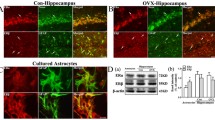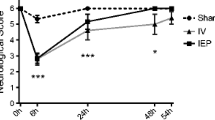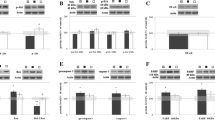Abstract
An increase of stroke incidence occurs in women with the decline of estrogen levels following menopause. This ischemic damage may recur, especially soon after the first insult has occurred. We evaluated the effects of estrogen and phytoestrogen treatment on an in vitro recurrent stroke model using the HT22 neuronal cell line. HT22 cells were treated with 17β-estradiol or genistein 1 h after the beginning of the first of two oxygen and glucose deprivation/reoxygenation (OGD/R) cycles. During the second OGD, there was a deterioration of some components of the electron transport chain, such as cytochrome c oxidase subunit 1 with a subsequent increase of reactive oxygen species (ROS) production. Accordingly, there was also an increase of apoptotic phenomena demonstrated by poly(ADP-ribose) polymerase 1 cleavage, Caspase-3 activity, and Annexin V levels. The recurrent ischemic injury also raised the hypoxia-inducible factor 1α and glucose transporter 1 levels, as well as the ratio between the lipidated and cytosolic forms of microtubule-associated protein 1A/1B-light chain 3 (LC3-II/LC3-I). We found a positive effect of estradiol and genistein treatment by partially preserving the impaired cell viability after the recurrent ischemic injury; however, this positive effect does not seem to be mediated neither by blocking apoptosis processes nor by decreasing ROS production. This work contribute to the better understanding of the molecular mechanisms triggered by recurrent ischemic damage in neuronal cells and, therefore, could help with the development of an effective treatment to minimize the consequences of this pathology.





Similar content being viewed by others
Abbreviations
- OGD/R:
-
Oxygen and glucose deprivation/reoxygenation
- OGD:
-
Oxygen and glucose deprivation
- CO-1:
-
Cytochrome c oxidase subunit 1
- ROS:
-
Reactive oxygen species
- PARP-1:
-
Poly(ADP-ribose) polymerase 1
- HIF-1α:
-
Hypoxia-inducible factor 1α
- GLUT:
-
Glucose transporter
- LC3:
-
Microtubule-associated protein 1A/1B-light chain 3
- I/R:
-
Ischemia/reperfusion
- ETC:
-
Electron transport chain
- PH:
-
Prolyl hydroxylase
- HRE:
-
Hypoxia response element
- ER:
-
Estrogen receptor
- SERM:
-
Selective estrogen receptor modulator
- DMEM:
-
Dulbecco’s Modified Eagle’s Medium
- FBS:
-
Fetal bovine serum
- N:
-
Cells cultured in complete medium under normoxia
- V:
-
Cells subjected to OGD or OGD/R and treated with vehicle
- E:
-
Cells subjected to OGD or OGD/R and treated with estradiol
- G:
-
Cells subjected to OGD or OGD/R and treated with genistein
- MTT:
-
3-(4,5-Dimethylthiazol-2-yl)-2,5-diphenyltetrazolium
- TBS-T:
-
Tris-HCL 20 mM pH 7.5, NaCl 150 mM, Tween-20 0,1 % v/v
- HRP:
-
Horseradish peroxidase
- ECL:
-
Enhanced chemiluminescence
- DCFDA:
-
2′,7′-Dichlorofluorescein diacetate
- PI:
-
Propidium iodide
- AV:
-
Annexin V
- CNS:
-
Central nervous system
References
Adamcio B, Sperling S, Hagemeyer N, Walkinshaw G, Ehrenreich H (2010) Hypoxia inducible factor stabilization leads to lasting improvement of hippocampal memory in healthy mice. Behav Brain Res 208:80–84
Aguirre A, Lopez-Alonso I, Gonzalez-Lopez A, Amado-Rodriguez L, Batalla-Solis E, Astudillo A, Blazquez-Prieto J, Fernandez AF, Galvan JA, Dos Santos CC, Albaiceta GM (2014) Defective autophagy impairs ATF3 activity and worsens lung injury during endotoxemia. J Mol Med (Berl) 92:665–676
Azcoitia I, Sierra A, Garcia-Segura LM (1999) Neuroprotective effects of estradiol in the adult rat hippocampus: interaction with insulin-like growth factor-I signalling. J Neurosci Res 58:815–822
Bagetta G, Chiappetta O, Amantea D, Iannone M, Rotiroti D, Costa A, Nappi G, Corasaniti MT (2004) Estradiol reduces cytochrome c translocation and minimizes hippocampal damage caused by transient global ischemia in rat. Neurosci Lett 368:87–91
Baker VL, Leitman D, Jaffe RB (2000) Selective estrogen receptor modulators in reproductive medicine and biology. Obstet Gynecol Surv 55:S21–S47
Beck V, Rohr U, Jungbauer A (2005) Phytoestrogen derived from red clover: an alternative to estrogen replacement therapy? J Steroid Biochem Mol Biol 94:499–518
Bolanos JP, Peuchen S, Heales SJ, Land JM, Clark JB (1994) Nitric oxide-mediated inhibition of the mitochondrial respiratory chain in cultured astrocytes. J Neurochem 63:910–916
Bradford MM (1976) A rapid and sensitive method for the quantitation of microgram quantities of protein utilizing the principle of protein-dye binding. Anal Biochem 72:248–254
Bursch W (2001) The autophagosomal-lysosomal compartment in programmed cell death. Cell Death Differ 8:569–581
Canu N, Tufi R, Serafino AL, Amadoro G, Ciotti MT, Calissano P (2005) Role of the autophagic-lysosomal system on low potassium-induced apoptosis in cultured cerebellar granule cells. J Neurochem 92:1228–1242
Catrina SB, Okamoto K, Pereira T, Brismar K, Poellinger L (2004) Hyperglycemia regulates hypoxia-inducible factor-1alpha protein stability and function. Diabetes 53:3226–3232
Chiueh C, Lee S, Andoh T, Murphy D (2003) Induction of antioxidative and antiapoptotic thioredoxin supports neuroprotective hypothesis of estrogen. Endocrine 21:27–31
Cohen GM (1997) Caspases: the executioners of apoptosis. Biochem J 326(Pt 1):1–16
Colditz GA (1999) Hormones and breast cancer: evidence and implications for consideration of risks and benefits of hormone replacement therapy. J Womens Health 8:347–357
Cortina B, Torregrosa G, Castello-Ruiz M, Burguete MC, Moscardo A, Latorre A, Salom JB, Valles J, Santos MT, Alborch E (2013) Improvement of the circulatory function partially accounts for the neuroprotective action of the phytoestrogen genistein in experimental ischemic stroke. Eur J Pharmacol 708:88–94
Daly E, Vessey MP, Hawkins MM, Carson JL, Gough P, Marsh S (1996) Risk of venous thromboembolism in users of hormone replacement therapy. Lancet 348:977–980
Duelli R, Kuschinsky W (2001) Brain glucose transporters: relationship to local energy demand. News Physiol Sci 16:71–76
Fornazari M, Nascimento IC, Nery AA, da Silva CC, Kowaltowski AJ, Ulrich H (2011) Neuronal differentiation involves a shift from glucose oxidation to fermentation. J Bioenerg Biomembr 43:531–539
Garrido P, Moran J, Alonso A, Gonzalez S, Gonzalez C (2013) 17beta-estradiol activates glucose uptake via GLUT4 translocation and PI3 K/Akt signaling pathway in MCF-7 cells. Endocrinology 154:1979–1989
Ginet V, Puyal J, Clarke PG, Truttmann AC (2009) Enhancement of autophagic flux after neonatal cerebral hypoxia-ischemia and its region-specific relationship to apoptotic mechanisms. Am J Pathol 175:1962–1974
Gu JH, Ge JB, Li M, Xu HD, Wu F, Qin ZH (2013) Poloxamer 188 protects neurons against ischemia/reperfusion injury through preserving integrity of cell membranes and blood brain barrier. PLoS ONE 8:e61641
Gulinello M, Lebesgue D, Jover-Mengual T, Zukin RS, Etgen AM (2006) Acute and chronic estradiol treatments reduce memory deficits induced by transient global ischemia in female rats. Horm Behav 49:246–260
Guo F, Wang H, Li L, Zhou H, Wei H, Jin W, Wang Q, Xiong L (2013) A novel domain of amino-Nogo-A protects HT22 cells exposed to oxygen glucose deprivation by inhibiting NADPH oxidase activity. Cell Mol Neurobiol 33:443–452
Huang Y, Lei L, Liu D, Jovin I, Russell R, Johnson RS, Di Lorenzo A, Giordano FJ (2012) Normal glucose uptake in the brain and heart requires an endothelial cell-specific HIF-1alpha-dependent function. Proc Natl Acad Sci USA 109:17478–17483
Huttemann M, Helling S, Sanderson TH, Sinkler C, Samavati L, Mahapatra G, Varughese A, Lu G, Liu J, Ramzan R, Vogt S, Grossman LI, Doan JW, Marcus K, Lee I (2012) Regulation of mitochondrial respiration and apoptosis through cell signaling: cytochrome c oxidase and cytochrome c in ischemia/reperfusion injury and inflammation. Biochim Biophys Acta 1817:598–609
Jiang BH, Jiang G, Zheng JZ, Lu Z, Hunter T, Vogt PK (2001) Phosphatidylinositol 3-kinase signaling controls levels of hypoxia-inducible factor 1. Cell Growth Differ 12:363–369
Kabeya Y, Mizushima N, Ueno T, Yamamoto A, Kirisako T, Noda T, Kominami E, Ohsumi Y, Yoshimori T (2000) LC3, a mammalian homologue of yeast Apg8p, is localized in autophagosome membranes after processing. EMBO J 19:5720–5728
Kaplan RC, Tirschwell DL, Longstreth WT Jr, Manolio TA, Heckbert SR, Lefkowitz D, El-Saed A, Psaty BM (2005) Vascular events, mortality, and preventive therapy following ischemic stroke in the elderly. Neurology 65:835–842
Kuiper GG, Lemmen JG, Carlsson B, Corton JC, Safe SH, van der Saag PT, van der Burg B, Gustafsson JA (1998) Interaction of estrogenic chemicals and phytoestrogen with estrogen receptor beta. Endocrinology 139:4252–4263
Kuroda S, Siesjo BK (1997) Reperfusion damage following focal ischemia: pathophysiology and therapeutic windows. Clin Neurosci 4:199–212
Liang HW, Qiu SF, Shen J, Sun LN, Wang JY, Bruce IC, Xia Q (2008) Genistein attenuates oxidative stress and neuronal damage following transient global cerebral ischemia in rat hippocampus. Neurosci Lett 438:116–120
Lopez-Alonso I, Aguirre A, Gonzalez-Lopez A, Fernandez AF, Amado-Rodriguez L, Astudillo A, Batalla-Solis E, Albaiceta GM (2013) Impairment of autophagy decreases ventilator-induced lung injury by blockade of the NF-kappaB pathway. Am J Physiol Lung Cell Mol Physiol 304:L844–L852
Maher F, Simpson IA (1994) The GLUT3 glucose transporter is the predominant isoform in primary cultured neurons: assessment by biosynthetic and photoaffinity labelling. Biochem J 301:379–384
Maher F, Davies-Hill TM, Lysko PG, Henneberry RC, Simpson IA (1991) Expression of two glucose transporters, GLUT1 and GLUT3, in cultured cerebellar neurons: evidence for neuron-specific expression of GLUT3. Mol Cell Neurosci 2:351–360
Malagelada C, Xifro X, Minano A, Sabria J, Rodriguez-Alvarez J (2005) Contribution of caspase-mediated apoptosis to the cell death caused by oxygen–glucose deprivation in cortical cell cultures. Neurobiol Dis 20:27–37
Marino G, Ugalde AP, Salvador-Montoliu N, Varela I, Quiros PM, Cadinanos J, van der Pluijm I, Freije JM, Lopez-Otin C (2008) Premature aging in mice activates a systemic metabolic response involving autophagy induction. Hum Mol Genet 17:2196–2211
Maxwell PH, Wiesener MS, Chang GW, Clifford SC, Vaux EC, Cockman ME, Wykoff CC, Pugh CW, Maher ER, Ratcliffe PJ (1999) The tumour suppressor protein VHL targets hypoxia-inducible factors for oxygen-dependent proteolysis. Nature 399:271–275
McEwen BS, Reagan LP (2004) Glucose transporter expression in the central nervous system: relationship to synaptic function. Eur J Pharmacol 490:13–24
Mehta SL, Kumari S, Mendelev N, Li PA (2012) Selenium preserves mitochondrial function, stimulates mitochondrial biogenesis, and reduces infarct volume after focal cerebral ischemia. BMC Neurosci 13:79
Moran J, Garrido P, Alonso A, Cabello E, Gonzalez C (2013) 17beta-Estradiol and genistein acute treatments improve some cerebral cortex homeostasis aspects deteriorated by aging in female rats. Exp Gerontol 48:414–421
Oliver FJ, de la Rubia G, Rolli V, Ruiz-Ruiz MC, de Murcia G, Murcia JM (1998) Importance of poly(ADP-ribose) polymerase and its cleavage in apoptosis. Lesson from an uncleavable mutant. J Biol Chem 273:33533–33539
Pelligrino DA, Santizo R, Baughman VL, Wang Q (1998) Cerebral vasodilating capacity during forebrain ischemia: effects of chronic estrogen depletion and repletion and the role of neuronal nitric oxide synthase. NeuroReport 9:3285–3291
Qian Y, Guan T, Huang M, Cao L, Li Y, Cheng H, Jin H, Yu D (2012) Neuroprotection by the soy isoflavone, genistein, via inhibition of mitochondria-dependent apoptosis pathways and reactive oxygen induced-NF-kappaB activation in a cerebral ischemia mouse model. Neurochem Int 60:759–767
Qin AP, Liu CF, Qin YY, Hong LZ, Xu M, Yang L, Liu J, Qin ZH, Zhang HL (2010) Autophagy was activated in injured astrocytes and mildly decreased cell survival following glucose and oxygen deprivation and focal cerebral ischemia. Autophagy 6:738–753
Reggiori F, Klionsky DJ (2002) Autophagy in the eukaryotic cell. Eukaryot Cell 1:11–21
Ryan HE, Lo J, Johnson RS (1998) HIF-1 alpha is required for solid tumor formation and embryonic vascularization. EMBO J 17:3005–3015
Sandau KB, Faus HG, Brune B (2000) Induction of hypoxia-inducible-factor 1 by nitric oxide is mediated via the PI 3 K pathway. Biochem Biophys Res Commun 278:263–267
Schreihofer DA, Redmond L (2009) Soy phytoestrogen are neuroprotective against stroke-like injury in vitro. Neuroscience 158:602–609
Schurr A, Rigor BM (1998) Brain anaerobic lactate production: a suicide note or a survival kit? Dev Neurosci 20:348–357
Semenza GL (2004) Hydroxylation of HIF-1: oxygen sensing at the molecular level. Physiology (Bethesda) 19:176–182
Sharp FR, Bergeron M, Bernaudin M (2001) Hypoxia-inducible factor in brain. Adv Exp Med Biol 502:273–291
Sheldahl LC, Shapiro RA, Bryant DN, Koerner IP, Dorsa DM (2008) Estrogen induces rapid translocation of estrogen receptor beta, but not estrogen receptor alpha, to the neuronal plasma membrane. Neuroscience 153:751–761
Shimada S, Hirabayashi M, Ishige K, Kosuge Y, Kihara T, Ito Y (2010) Activation of dopamine D4 receptors is protective against hypoxia/reoxygenation-induced cell death in HT22 cells. J Pharmacol Sci 114:217–224
Simpkins JW, Rajakumar G, Zhang YQ, Simpkins CE, Greenwald D, Yu CJ, Bodor N, Day AL (1997) Estrogen may reduce mortality and ischemic damage caused by middle cerebral artery occlusion in the female rat. J Neurosurg 87:724–730
Singer CA, Rogers KL, Strickland TM, Dorsa DM (1996) Estrogen protects primary cortical neurons from glutamate toxicity. Neurosci Lett 212:13–16
Spinella F, Rosano L, Del Duca M, Di Castro V, Nicotra MR, Natali PG, Bagnato A (2010) Endothelin-1 inhibits prolyl hydroxylase domain 2 to activate hypoxia-inducible factor-1alpha in melanoma cells. PLoS ONE 5:e11241
Sun YY, Lin SH, Lin HC, Hung CC, Wang CY, Lin YC, Hung KS, Lien CC, Kuan CY, Lee YH (2013) Cell type-specific dependency on the PI3 K/Akt signaling pathway for the endogenous Epo and VEGF induction by baicalein in neurons versus astrocytes. PLoS ONE 8:e69019
Suzuki S, Brown CM, Wise PM (2009) Neuroprotective effects of estrogen following ischemic stroke. Front Neuroendocrinol 30:201–211
Tian F, Deguchi K, Yamashita T, Ohta Y, Morimoto N, Shang J, Zhang X, Liu N, Ikeda Y, Matsuura T, Abe K (2010) In vivo imaging of autophagy in a mouse stroke model. Autophagy 6:1107–1114
Towbin H, Staehelin T, Gordon J (1979) Electrophoretic transfer of proteins from polyacrylamide gels to nitrocellulose sheets: procedure and some applications. Proc Natl Acad Sci USA 76:4350–4354
Towfighi A, Saver JL, Engelhardt R, Ovbiagele B (2007) A midlife stroke surge among women in the United States. Neurology 69:1898–1904
van Wijk SJ, Hageman GJ (2005) Poly(ADP-ribose) polymerase-1 mediated caspase-independent cell death after ischemia/reperfusion. Free Radic Biol Med 39:81–90
Wang GL, Jiang BH, Rue EA, Semenza GL (1995) Hypoxia-inducible factor 1 is a basic-helix-loop-helix-PAS heterodimer regulated by cellular O2 tension. Proc Natl Acad Sci USA 92:5510–5514
Wang L, Chen M, Yuan L, Xiang Y, Zheng R, Zhu S (2014a) 14,15-EET promotes mitochondrial biogenesis and protects cortical neurons against oxygen/glucose deprivation-induced apoptosis. Biochem Biophys Res Commun 450:604–609
Wang S, Wei H, Cai M, Lu Y, Hou W, Yang Q, Dong H, Xiong L (2014b) Genistein attenuates brain damage induced by transient cerebral ischemia through up-regulation of ERK activity in ovariectomized mice. Int J Biol Sci 10:457–465
Yu J, Li J, Zhang S, Xu X, Zheng M, Jiang G, Li F (2012) IGF-1 induces hypoxia-inducible factor 1alpha-mediated GLUT3 expression through PI3 K/Akt/mTOR dependent pathways in PC12 cells. Brain Res 1430:18–24
Zhang Z, Yan J, Taheri S, Liu KJ, Shi H (2014) Hypoxia-inducible factor 1 contributes to N-acetylcysteine’s protection in stroke. Free Radic Biol Med 68:8–21
Acknowledgments
This study was funded by European Union FEDER funds, Plan de Ciencia, Tecnología e Innovación del Principado de Asturias, FICYT (GRUPIN 14-069).
Author information
Authors and Affiliations
Corresponding author
Ethics declarations
Conflict of Interest
The authors declare that they have no conflict of interest.
Rights and permissions
About this article
Cite this article
Morán, J., Perez-Basterrechea, M., Garrido, P. et al. Effects of Estrogen and Phytoestrogen Treatment on an In Vitro Model of Recurrent Stroke on HT22 Neuronal Cell Line. Cell Mol Neurobiol 37, 405–416 (2017). https://doi.org/10.1007/s10571-016-0372-1
Received:
Accepted:
Published:
Issue Date:
DOI: https://doi.org/10.1007/s10571-016-0372-1




